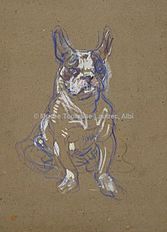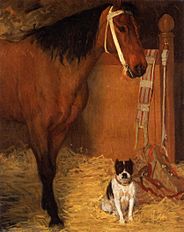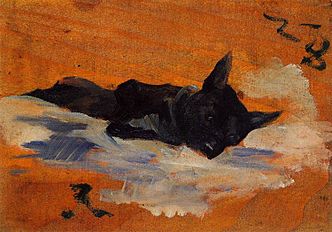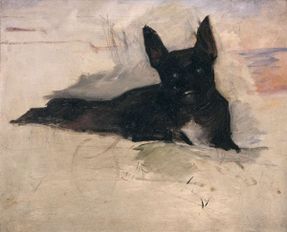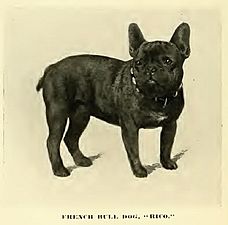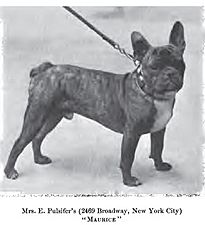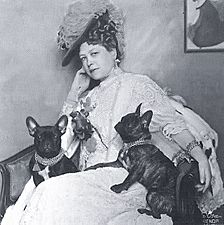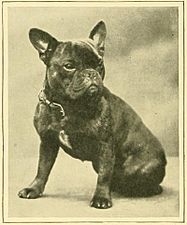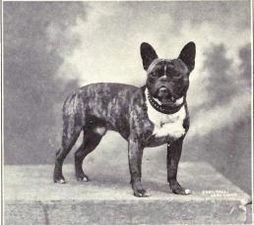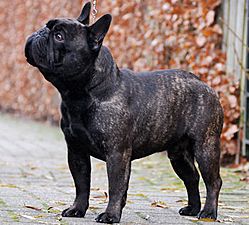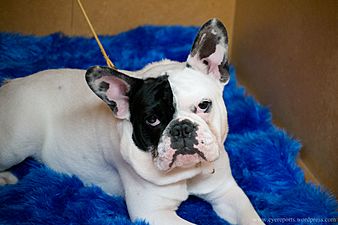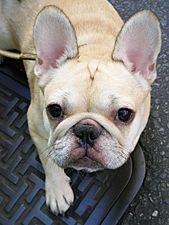French Bulldog facts for kids
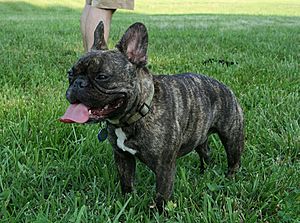 |
|||||||||||||||||||||
| Other names | Bouledogue Français | ||||||||||||||||||||
|---|---|---|---|---|---|---|---|---|---|---|---|---|---|---|---|---|---|---|---|---|---|
| Origin | France | ||||||||||||||||||||
|
|||||||||||||||||||||
|
|||||||||||||||||||||
| Domestic dog (Canis lupus familiaris) | |||||||||||||||||||||
The French Bulldog, also known as the Bouledogue Français, is a popular dog breed from France. These dogs are known for being great companion dogs or toy dogs. They first appeared in Paris in the mid-1800s. They likely came from mixing small Toy Bulldogs from England with local Parisian dogs used for catching rats.
Today, French Bulldogs are very popular pets. They are among the most registered dogs in countries like Australia, the United Kingdom, and the United States. However, because of their unique look, like their flat faces and skin wrinkles, they can have some serious health problems.
Contents
History of the French Bulldog
In the early 1800s, bulldogs in the United Kingdom were bred for new reasons. Old activities like bull-baiting were banned in 1835. By the mid-1800s, there were miniature bulldogs. These smaller dogs often weighed between 7 and 11 kilograms (about 15-24 pounds). Some were even smaller.
Around the same time, lace workers from Nottingham, England, moved to Normandy, France. This happened because of the Industrial Revolution, which changed how goods were made. These workers brought their Toy Bulldogs with them. The dogs quickly became popular in France. English breeders even started sending smaller bulldogs or those with "faults" (like ears that stood up) to France. By 1860, most Toy Bulldogs were in France, not England.
The small bulldog type slowly became its own breed. It was named the Bouledogue Francais. This French name combines "boule" (ball) and "dogue" (mastiff). These dogs became very fashionable. Society ladies, artists, writers, and fashion designers all wanted them. Famous artists like Edgar Degas and Henri de Toulouse-Lautrec are believed to have included French Bulldogs in their paintings. As the breed changed, some terrier dogs were likely bred in. This helped develop traits like their long, straight ears.
French Bulldogs in Old Paintings
-
Toulouse-Lautrec: Bouboule, Bull-dog de madame Palmyre, à la souris, 1897
-
A l'écurie, cheval et chien, Edgar Degas, about 1861
How the Breed Became Known
Americans started bringing French Bulldogs to the U.S. in the late 1800s. In 1885, people began breeding them in America. Many were owned by wealthy women. They first showed these dogs at the Westminster Kennel Club Dog Show in 1896. A judge in 1897 only chose dogs with "rose ears" (ears that folded). So, the owners formed the French Bull Dog Club of America. They created a breed standard that preferred the "erect bat ear" type.
In the early 1900s, French Bulldogs were still very popular with high society. Some dogs were sold for as much as $3,000. Important families like the Rockefellers and the J. P. Morgans owned them. The American Kennel Club quickly recognized the breed. By 1906, the French Bulldog was the fifth most popular dog breed in America.
The first French Bulldogs arrived in England in 1893. English Bulldog breeders were upset because these French dogs did not meet their standards. They worried about crossbreeding. The Kennel Club in England first saw them as a type of existing Bulldog. Some English breeders even used French Bulldogs to try and bring back the Toy Bulldog.
On July 10, 1902, a meeting was held to create a breed club for the French type. They wanted it to be recognized as its own breed. They used the same breed standard already used in America, France, Germany, and Austria. Despite some opposition, the Kennel Club changed its mind in 1905. They recognized the French Bulldog as a separate breed. It was first called the Bouledogue Francais, then in 1912, the French Bulldog.
Today, the French Bulldog is a very common pet. In 2020, it was the second most registered dog in the UK. It was the fourth most popular in the U.S. In Australia, it was the third most popular in 2017. In 2023, the French Bulldog became the most popular dog breed in the U.S. This was according to the AKC. Before this, Labrador Retrievers had been number one for 31 years!
Old Photos of French Bulldogs
What French Bulldogs Look Like
The American Kennel Club (AKC) says French Bulldogs should be muscular. They have a soft, loose coat that forms wrinkles. An AKC-approved French Bulldog should weigh no more than about 12.7 kilograms (28 pounds).
Their head should be large and square-shaped. Their ears should look like bat ears. French Bulldogs are a flat-faced breed. Their eyes should be dark, almost black. Blue-eyed French Bulldogs are not approved by the AKC standard. Their coat should be short, fine, and silky.
Accepted colors for the breed include different shades of brindle, fawn, cream, or white with brindle patches (called "pied"). Fawn colors can range from light to red. The most common colors are brindle, then fawn. Pied dogs are less common. Breed clubs do not recognize other colors or patterns.
French Bulldog Health
French Bulldogs are known to have certain health issues. A study in the UK compared French Bulldogs to other dogs. It found that French Bulldogs had more health problems in almost half of the common conditions studied. They had fewer problems in about a quarter of conditions.
For example, narrow nostrils (called Stenotic nares) were 42 times more common in French Bulldogs. Breathing problems due to their flat face (brachycephalic obstructive airway syndrome) were 30 times more common. Ear discharge was 14 times more common. Skin fold infections (skin fold dermatitis) were 11 times more common. Difficult births (dystocia) were 9 times more common.
A 2013 UK study looked at the health of over 2,200 French Bulldogs. It found that most (72.4%) had at least one health issue. The most common problems were ear infections (14%), diarrhea (7.5%), and eye infections (3.2%). Skin problems were the most common group of issues (17.9%).
Brachycephaly and Breathing
The short snout and pushed-in face of the French Bulldog is called brachycephaly. This shape can cause problems in their upper airway. It makes it hard for them to breathe properly. Issues from brachycephaly include noisy breathing, snoring, vomiting, skin fold infections, and eye problems. They can also have a strong gag reflex, bluish skin (from lack of oxygen), and throat collapse.
Dogs with brachycephaly also have a higher risk of problems during anesthesia. They can also get too hot easily (hyperthermia). This is because they can't cool themselves down well by panting. Some airlines do not allow French Bulldogs to fly. This is due to the number of dogs that have died during air travel.
Life Expectancy
A study in the UK looked at the deaths of over 30,000 dogs. It found that French Bulldogs had a life expectancy of about 4.5 years at birth. This was the lowest among all breeds in the study. The average for all dogs was about 11.2 years. However, this low number might be because many French Bulldogs are very young. The breed's popularity has grown a lot in the UK. This means there are many young dogs, which can make the average seem lower. A study in Japan found French Bulldogs lived about 10.2 years. This was also the lowest among breeds in that study.
Birth and Reproduction
French Bulldogs often need surgery to give birth. This surgery is called a Caesarean section. More than 80% of French Bulldog litters are born this way.
Bone and Joint Health
French Bulldogs can be born with unusual shapes in their spine. These are called hemivertebrae or "butterfly vertebrae." They can be seen on an X-ray.
A review of over 200,000 dogs in the UK found that French Bulldogs had a much higher chance of knee cap problems. This condition is called patellar luxation.
Other Health Conditions
A study in France found that 45% of French Bulldogs with nerve problems had a specific type of spinal disk herniation. This suggests French Bulldogs are prone to this back condition. Another UK study found French Bulldogs were more likely to have problems with their upper spine bones.
See also
 In Spanish: Bulldog francés para niños
In Spanish: Bulldog francés para niños


